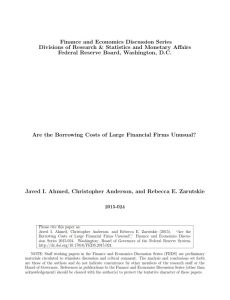Join getAbstract to access the summary!

Join getAbstract to access the summary!
Javed I. Ahmed, Christopher Anderson and Rebecca E. Zarutskie
Are the Borrowing Costs of Large Financial Firms Unusual?
Federal Reserve Board, 2015
What's inside?
Government support of financial firms boosts the market perception of their safety. But is that why they have lower borrowing costs?
Recommendation
The too-big-to-fail phenomenon received ample attention after the US government bailed out several large financial institutions in 2008 and 2009. One way to gauge the market impacts of implicit government guarantees is to compare the borrowing costs of financial firms with those of nonfinancial companies. If large financial institutions have lower borrowing costs than others, it stands to reason that investors believe that the implied state support means less risk. But does that tell the whole story? With its ambiguous conclusion, this report from economists Javed I. Ahmed, Christopher Anderson and Rebecca E. Zarutskie may leave readers with more questions than answers. Nonetheless, getAbstract recommends it to financial regulators and professionals.
Summary
About the Authors
Javed I. Ahmed and Rebecca E. Zarutskie are economists at the Board of Governors of the Federal Reserve System. Christopher Anderson is a PhD candidate at Harvard Business School.


















Comment on this summary